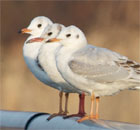Japanese Bird Name Pronunciation Guide
The characteristics of Japanese language pronunciation are as follows:
- There are five vowels: a, i, u, e, o (in Japanese order).
- Unlike English, each vowel is always pronounced the same way: a = "ah" (swan); i = "ee" (eel); u = "oo" (food); e = short "e" (ĕ, as in pet); o = "oh" (hold). When two vowels occur together, such as in Utou (Rhinoceros Auklet) or Ao-sagi (Grey Heron), they are pronounced separately.
- Vowels can be long (extended) or short. This occurs mainly with u and o: e.g. Nyuunai-suzume (Russet Sparrow) which has a long u in "Nyuu", written ニュウ (nyu+u); Houroku-shigi (Far Eastern Curlew) with a long o in "Hou", written ホウ (ho+u); or Hakuchou (swan) with a long o in "chou", written チョウ (cho+u). There is also an extended o in Oo-washi (Stellar's Sea-Eagle), written オオ (o+o), which comes from the Japanese word for "large", ookii; and in Hoojiro-gamo (Goldeneye but literally "White-cheeked Duck") where the Japanese word for cheek is hoo, ホオ (ho+o). Then there is Kyoujo-shigi (Ruddy Turnstone) which has both long and short "o's". Macrons over o or u (ō, ū) are also sometimes used to romanize extended vowels in Japanese, and sometimes no distinction is made (frequently the case in place names or personal names). Here I simply romanize bird names as they appear in katakana and add hyphens to separate components for clarity.
- Japanese syllables are always open (ending in a vowel), except in the case of those that end in "n" (ン), as in Kanmuri-kaitsuburi (Crested Grebe) where Kanmuri is written カンムリ (ka+n+mu+ri). (Japanese linguists might argue that "n" is a separate syllable, since it is written with a separate kana, in which case "n" would be the closed syllable.)
- An interesting characteristic of the Japanese kana alphabet is that it is two-dimensional. There are actually two alphabets, hiragana and katakana. Bird names are normally written in katakana, so we just focus on that one here. A PDF of the table below can be downloaded here (108KB, opens on a separate page).

[by Douglas Braat]



